Yamaha SPX1000 User Manual

YAMAHA
AUTHORIZED PRODUCT MANUAL
Professional Multi-effect Processor
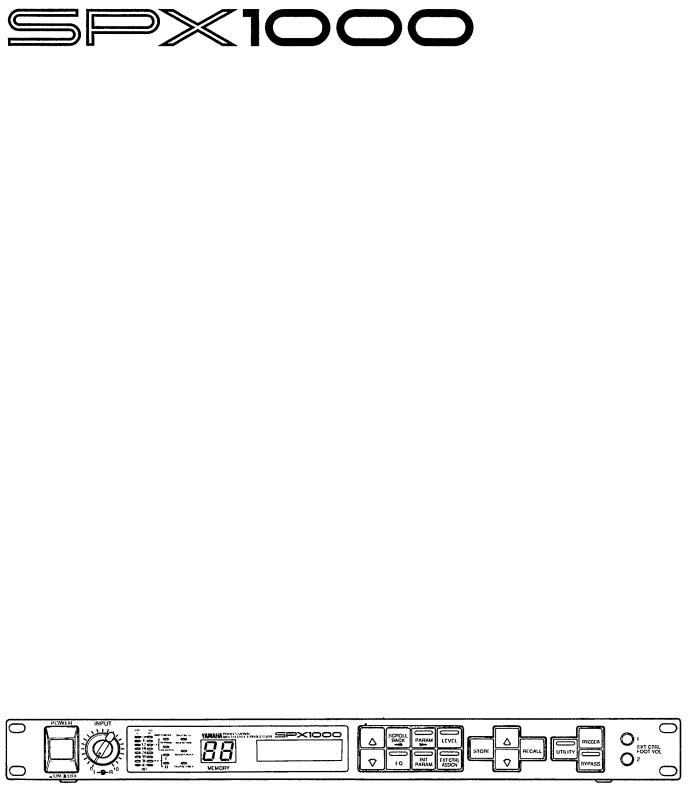
YAMAHA
Professional Multi-effect Processor
Operation Manual
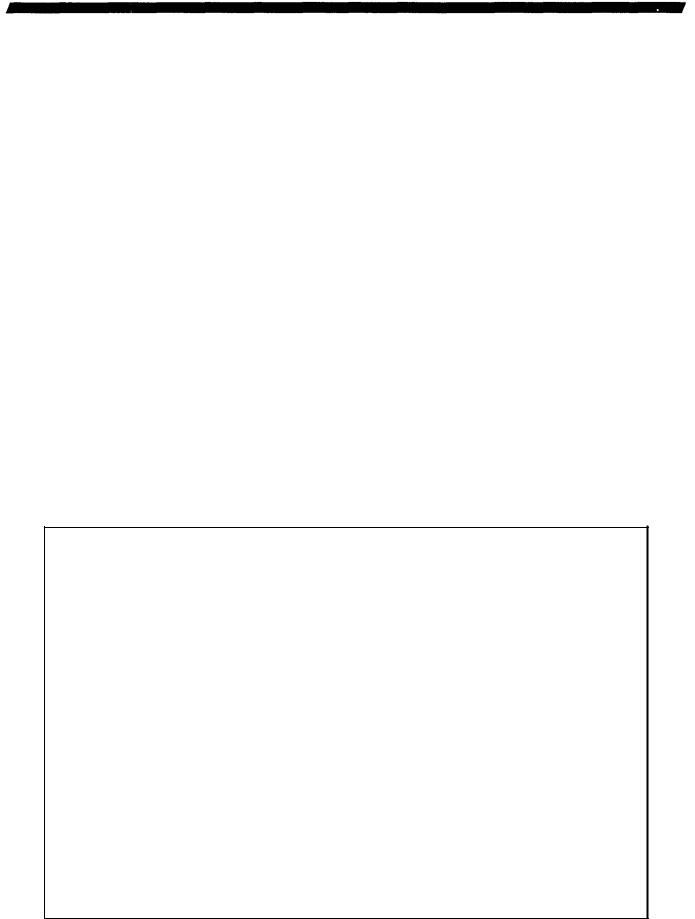
INTRODUCTION
Congratulations on your acquisition of a Yamaha SPX1000 Professional Multi-effect Processor. The SPX1000 is a highly sophisticated digital reverberation and effects system which offers 40 preset effect programs including accurate simulations of natural reverberation and early-reflections, delay and echo effects, gated effects, modulation effects, a versatile compressor, a low-level expander, a harmonic exciter, multiple effects which function as several SPX000 units in one, independent 2-channel effects, freeze (sampling) programs and others. With a sampling frequency of 44. 1 kHz, it delivers full, flat frequency response from 20 Hz to 20 kHz for exceptionally clean, “transparent” effect sound, and direct digital interfacing capability makes it compatible with the most up-to- date sound systems. The preset effect programs can be edited, re-titled, and stored in any of 59 RAM user memory locations. Individual two-band parametric EQ and dynamic filter parameters are provided for each effect program for precise tonal tailoring. In addition to the basic effect and EQ parameters, the SPX1000 offers a list of “internal parameters” which provide exacting control over the effect sound. The SPX1000 is also MIDI compatible, with a MIDI IN terminal that allows MIDI selection of effect programs, and a switchable MIDI THRU/OUT terminal. When switched to OUT, edited programs stored in internal RAM can be dumped to a MIDI data recorder or other data storage device. Programs thus stored can be reloaded when necessary via the MIDI IN terminal. As an extra touch of convenience the SPX1000’s analog input and output terminals can be switched to match -20 dBm or +4 dBm line levels + providing compatibility with a broader range of sound equipment.
In order to fully take advantage of all the capability offered by the SPX1000 Professional Multi-effect Processor, we urge you to read this operation manual thoroughly— and keep it in a safe place for later reference.
FCC INFORMATION
While the following statements are provided to comply with FCC Regulations in the United States, the corrective measures listed below are applicable worldwide.
This series of Yamaha professional music equipment uses frequencies that appear in the radio frequency range and if installed in the immediate proximity of some types of audio or video devices (within three meters), interference may occur. This series of Yamaha combo equipment have been type tested and found to comply with the specifications set for a class B computing device in accordance with those specifications listed in subpart J of part 15 of the FCC rules. These rules are designed to provide a reasonable measure of protection against such interference. However, this does not guarantee that interference will not occur. If your professional music equipment should be suspected of causing interference with other electronic devices, verification can be made by turning your combo equipment off and on. If the interference continues when your equipment is off, the equipment is not the source of interference. If your equipment does appear to be the source of the interference, you should try to correct the situation by using one or more of the following measures:
Relocate either the equipment or the electronic device that is being affected by the interference. Utilize power outlets for the professional music equipment and the device being affected that are on different branch (circuit breaker or fuse) circuits, or install AC line filters.
In the case of radio or TV interference, relocate the antenna or, if the antenna lead-in is 300 ohm ribbon lead, change the lead-in to co-axial type cable.
If these corrective measures do not produce satisfactory results, please contact your authorized Yamaha professional products dealer for suggestions and/or corrective measures.
If you cannot locate a franchised Yamaha professional products dealer in your general area contact the professional products Service Department, Yamaha Music Corporation, 6600 Orangethorpe Ave., Buena Park, CA 90620, U.S.A.
If for any reason. you should need additional information relating to radio or TV interference, you may find a booklet prepared by the Federal Communications Commission helpful:
“How to identify and Resolve Radio-TV Interference Problems”. This booklet is available from the U.S. Government Printing Office, Washington D.C. 20402 - Stock No. 004-000-00345-4.
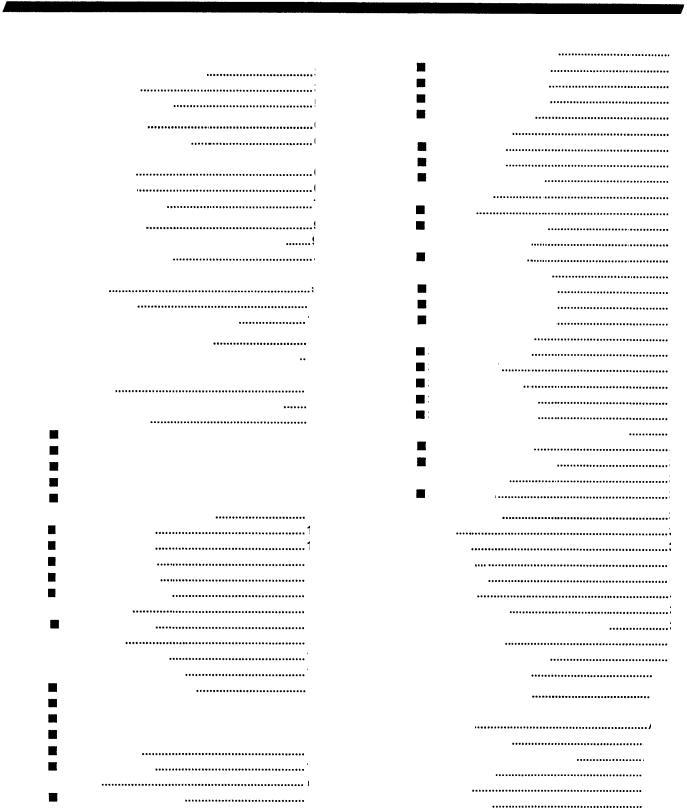
TABLE OF CONTENTS
PRECAUTIONS |
|
1: CONTROLS AND CONNECTIONS |
3 |
THE FRONT PANEL |
3 |
THE CONNECTOR PANEL |
5 |
2: THE SPX1000 SYSTEM |
6 |
MEMORY CONFIGURATION |
6 |
INPUT MODE AND DIGITAL I/O |
|
CONFIGURATIONS |
6 |
INPUT MODES |
6 |
DIGITAL l/O MODES |
7 |
3: GENERAL OPERATION |
9 |
SELECTING AN EFFECT/MEMORY LOCATION |
9 |
BYPASSING THE EFFECT |
9 |
ACCESSING & EDITING THE PROGRAM |
|
PARAMETERS |
9 |
STORING EFFECTS |
10 |
EXTERNAL CONTROL ASSIGNMENT |
10 |
4: THE PROGRAMS & PARAMETERS |
12 |
PARAMETERS PROVIDED FOR ALL PROGRAMS |
12 |
LEVEL PARAMETERS (Accessed via |
|
LEVEL key) |
12 |
EQ PARAMETERS (Accessed via EQ key) |
12 |
REVERB PROGRAMS |
13 |
1.REV 1 HALL  13
13
2.REV 2 ROOM  13
13
3.REV 3 VOCAL  13
13
4.REV 4 PLATE 14
14
5.REV 5 ECHO ROOM  15
15
EARLY REFLECTION PROGRAMS |
15 |
6. EARLY REF. 1 |
15 |
7. EARLY REF. 2 |
15 |
8. EARLY REF. 3 |
15 |
9. GATE REVERB |
15 |
10. REVERSE GATE.. |
15 |
DELAY PROGRAM |
17 |
11. DELAY L,C,R |
17 |
ECHO PROGRAM |
17 |
12. STEREO ECHO |
17 |
MODULATION PROGRAMS |
18 |
13. STEREO FLANGE A |
18 |
14.STEREO FLANGE B 18
18
15.CHORUS  18
18
16.STEREO PHASING 18
18
17. TREMOLO |
18 |
18. SYMPHONIC |
18 |
NOISE GATE |
19 |
19. ADR-NOISE GATE |
19 |
PITCH CHANGE PROGRAMS |
19 |
20. PITCH CHANGE 1 |
20 |
21. PITCH CHANGE 2 |
20 |
22. PITCH CHANGE 3 |
20 |
39. STEREO PITCH |
21 |
FREEZE PROGRAMS |
21 |
23. FREEZE 1 |
21 |
24. FREEZE 2 |
23 |
40. STEREO FREEZE |
23 |
PAN PROGRAMS |
23 |
25. PAN |
24 |
26. TRIGGERED PAN |
24 |
DISTORTION PROGRAM |
24 |
27. DISTORTION |
24 |
MULTI-EFFECT PROGRAMS |
25 |
28. MULTI (CHO&REV) |
25 |
2 9 . M U L T I ( S Y M + R E V ) |
2 6 |
30. MULTI (EXC&REV) |
26 |
2-CHANNEL PROGRAMS |
26 |
31. PLATE + HALL |
26 |
32. ER + REV |
27 |
33. ECHO + REV |
27 |
34. CHORUS + REV |
28 |
35. PAN + PAN |
28 |
COMPRESSOR & EXPANDER PROGRAMS |
29 |
36. COMPRESSOR |
29 |
37. LO LVL EXPANDER |
30 |
EXCITER PROGRAM |
30 |
38. EXCITER |
30 |
5: UTILITY FUNCTIONS |
31 |
TITLE EDIT |
31 |
INPUT MODE |
31 |
A/D l/O MODE |
31 |
DIGITAL IN ATT |
31 |
USER ER EDIT |
31 |
MEMORY PROTECT |
32 |
MIDI CONTROL & MIDI PGM CHANGE |
32 |
MIDI CTRL ASSIGN |
33 |
BULK OUT 1 & BULK OUT 2 |
33 |
F.SW MEMORY RCL |
34 |
6: DATA & SPECIFICATIONS |
Add-1 |
ROM CONTENTS AND CONTROLLABLE |
|
PARAMETERS |
Add-1 |
MIDI DATA FORMAT |
Add-15 |
MIDI IMPLEMENTATION CHART |
Add-28 |
BLOCK DIAGRAM |
Add-29 |
DIMENSIONS |
Add-30 |
SPECIFICATIONS |
Add-31 |
1

PRECAUTIONS
1. AVOID EXCESSIVE HEAT, HUMIDITY, DUST AND VIBRATION
Keep the unit away from locations where it is likely to be exposed to high temperatures or humidity – such as near radiators, stoves, etc. Also avoid locations which are subject to excessive dust accumulation or vibration which could cause mechanical damage.
2.AVOID PHYSICAL SHOCKS
Strong physical shocks to the unit can cause damage. Handle it with care.
3.DO NOT OPEN THE CASE OR ATTEMPT REPAIRS OR MODIFICATIONS YOURSELF
This product contains no user-serviceable parts. Refer all maintenance to qualified Yamaha service
personnel. Opening the case and/or tampering with the internal circuitry will void the warranty.
4.MAKE SURE POWER IS OFF BEFORE MAKING OR REMOVING CONNECTIONS
Always turn the power OFF prior to connecting or disconnecting cables. This is important to prevent damage to the unit itself as well as other connected equipment.
5.HANDLE CABLES CAREFULLY
Always plug and unplug cables – including the AC cord – by gripping the connector, not the cord.
6.CLEAN WITH A SOFT DRY CLOTH
Never use solvents such as benzine or thinner to clean the unit. Wipe clean with a soft, dry cloth.
7.ALWAYS USE THE CORRECT POWER SUPPLY
Make sure that the power supply voltage specified on the rear panel matches your local AC mains supply.
8.ELECTRICAL INTERFERENCE
Since the SPX000 contains digital circuitry, it may cause interference and noise if placed too close to TV sets, radios or similar equipment. If such a problem does occur, move the SPX1000 further away from the affected equipment.
9. BACKUP BATTERY
The SPX1000 contains a long-life lithium battery which maintains the contents of the buffer and user memory locations even when the unit is turned OFF. With normal use the battery should last for approximately 5 years. If the battery voltage falls below the safe level, however, the "*** WARNING *** LOW BATTERY” display will appear on the LCD when the power is first turned ON. If this occurs, have the battery replaced by a qualified Yamaha service center. Do not attempt to replace the battery yourself!
IMPORTANT NOTICE FOR THE UNITED KINGDOM
Connecting the Plug and Cord
WARNING : THIS APPARATUS MUST BE EARTHED
IMPORTANT. The wires in this mains lead are coloured in accordance with the following code:
GREEN-AND-YELLOW : EARTH
BLUE |
: |
NEUTRAL |
BROWN |
: |
LlVE |
As the colours of the wires in the mains lead of this apparatus may not correspond with the coloured markings identifying the terminals in your plug proceed as follows:
The wire which is coloured GREEN-AND-YELLOW must be connected to the terminal in the plug which is marked by the letter E or by the safety earth symbol  or coloured GREEN or GREEN- AND-YELLOW.
or coloured GREEN or GREEN- AND-YELLOW.
The wire which is coloured BLUE must be connected to the terminal which is marked with the letter N or coloured BLACK.
The wire which is coloured BROWN must be connected to the terminal which is marked with the letter L or coloured RED.
CANADA
THIS APPARATUS COMPLIES WITH THE "CLASS B” LIMITS FOR RADIO NOISE EMISSIONS SET OUT IN RADIO INTERFERENCE REGULATIONS.
CET APPAREIL EST CONFORME AUX NORMES “CLASSE B”. POUR BRUITS RADIOELECTRIQUES. TEL QUE SPECIFIER DANS LE REGLEMENT SUR LE BROUILLAGE RADIOELECTRIQUE.
2
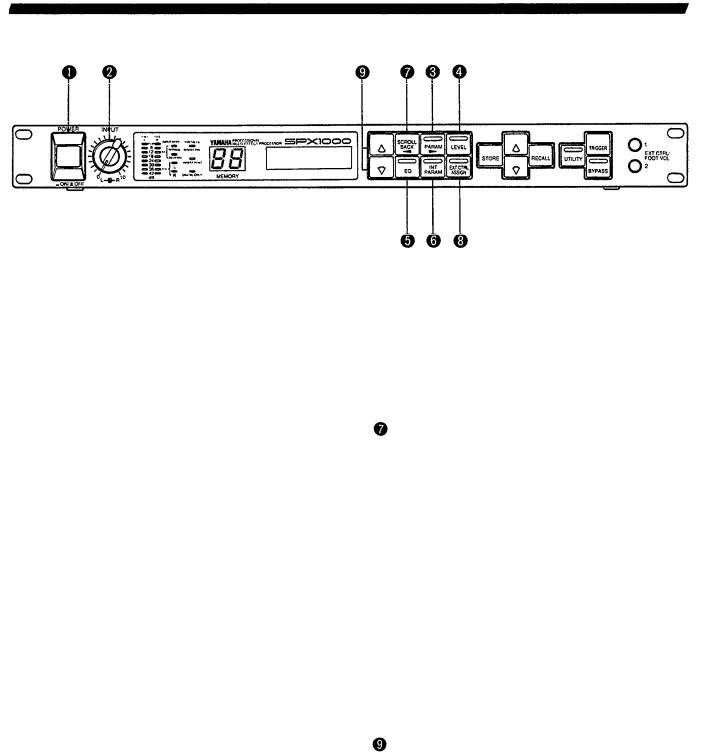
1: CONTROLS AND CONNECTIONS
THE FRONT PANEL
 Power ON/OFF Switch
Power ON/OFF Switch
Press to turn power ON, press again to turn power OFF. When the power is turned ON, the last program and parameter selected will be automatically recalled.
 Input Level Controls
Input Level Controls
These concentric controls vary the input level of the analog inputs from approximately -90 dB to +l0 dB when the rear-panel input level switch is set to +4 dB, and between approximately -110 dB and -14 dB when the input level switch is set to -20 dB. The inner control adjusts the left channel and the outer control adjusts the right channel.
 PARAM Key
PARAM Key
Accesses the main effect parameters for each program. Each time the PARAM key is pressed the next parameter in the selected program’s “parameter set” is called. It is also possible to scroll backward through the parameter set by using the SCROLL BACK key (7). Once the desired parameter has been selected its value or setting can be changed using the parameter and
and keys (9). The PARAM key is also used for cursor control (forward cursor movement) in some utility functions.
keys (9). The PARAM key is also used for cursor control (forward cursor movement) in some utility functions.
•Details under “THE PROGRAMS & PARAMETERS” starting on page 12
 LEVEL Key
LEVEL Key
Accesses the output level and balance parameters for each program. Once the LEVEL key has been pressed, both the LEVEL key and SCROLL BACK (7) key can be used to select parameters. Once the desired parameter has been selected its value or setting can be changed using the parameter  and
and keys (9).
keys (9).
• Details on page 12
 EQ Key
EQ Key
Accesses the digital equalizer or dynamic filter parameters for each program. Once the EQ key has been pressed, both the EQ key and SCROLL BACK (7) key can be used to select parameters. Once the desired parameter has been selected its value or setting can be changed using the parameter  and
and keys (9).
keys (9).
• Details on page 12
 INT PARAMETER Key
INT PARAMETER Key
Accesses a special set of internal parameters for each effect program. Once the INT PARAM key has been pressed, both the INT PARAM key and SCROLL BACK
(7) key can be used to select parameters. Once the desired parameter has been selected its value or setting can be changed using the parameter  and
and keys (9).
keys (9).
•Details under “THE PROGRAMS & PARAMETERS” starting on page 12
SCROLL BACK Key 
When any set of parameters is selected – PARAM, LEVEL, EQ, or INT PARAM – the SCROLL BACK key can be used to scroll backward through the available parameters while the PARAM (3), LEVEL (4), EQ (5) or INT PARAMETER (6) key scrolls forward, according to the parameter set selected. The preceding parameter in the current set is selected each time the SCROLL BACK key is pressed. The SCROLL BACK key is also used for cursor control (backward cursor movement) in some utility functions.
 EXT CTRL ASSIGN Key
EXT CTRL ASSIGN Key
This key makes it possible to assign any parameters (PARAM, LEVEL, EQ or INT PARAM) to external controllers connected to the front-panel EXT CTRL/ FOOT VOL 1 and 2 jacks (21). These controllers can then be used to control the assigned parameter in real time. Yamaha FC7 Foot Controllers are recommended.
• Details on page 10
Parameter  and
and  Keys
Keys
These keys are used to change parameter values when parameters are selected for editing (after the PARAM, LEVEL, EQ or INT PARAM key has been pressed). The parameter  and
and keys are also used to program several UTILITY functions. The
keys are also used to program several UTILITY functions. The and
and keys can be pressed briefly to change values in single steps, or held down for rapid continuous incrementing or decrementing of the selected value. While holding down either the
keys can be pressed briefly to change values in single steps, or held down for rapid continuous incrementing or decrementing of the selected value. While holding down either the or
or key, pressing the other key
key, pressing the other key or
or causes the incrementing or decrementing process to be carried out more rapidly.
causes the incrementing or decrementing process to be carried out more rapidly.
3

Program Select and Keys
and Keys
These keys are used to select any of the SPX1000’s memory locations. The key increments (increases) the memory location number while the
key increments (increases) the memory location number while the key decrements (decreases) the memory location number. Holding either key down causes continuous scrolling in the specified direction.
key decrements (decreases) the memory location number. Holding either key down causes continuous scrolling in the specified direction.
• Details on page 9
RECALL Key
When a new memory location number has been selected using the program select  and
and keys, the RECALL key must be pressed to activate the selected effect.
keys, the RECALL key must be pressed to activate the selected effect.
• Details on page 9
STORE Key
This key is used to store edited effect programs into one of the user memory locations between 41 and 99.
• Details on page 10
UTILITY Key
This key accesses a set of utility functions allowing selection of the SPX1000's input/output mode, editing of effect titles, creation of original early-reflection patterns, MIDI control programming, footswitch recall range programming and others.
• Details on page 31
 TRIGGER Key
TRIGGER Key
The TRIGGER key allows manual triggering of any SPX1000 effect program that has trigger parameters. The reverb programs, for example, include a triggerable gate, and the freeze programs allow triggering of recording and playback. The TRIGGER key has the same function as a footswitch plugged into the rear-panel TRIGGER 1 SW jack (THE CONNECTOR PANEL, 6).
 BYPASS Key
BYPASS Key
The BYPASS key switches the selected effect ON or OFF. leaving only the direct signal when BYPASS is active. The BYPASS key has the same function as a footswitch plugged into the rear-panel BYPASS jack (THE CONNECTOR PANEL, 4).
• Details on page 9
LCD (Liquid Crystal Display)
This 16-character x 2-line liquid crystal display panel normally displays the title of the selected effect on the top line and a selected parameter and its value on the bottom line. One or both lines may also be used to display error messages or warnings. “M” will be displayed in the upper right corner after receiving the MIDI data.
LED Memory Number Display
This 2-digit numeric display shows the number of the currently selected memory location (1 – 99). When the LED display is continuously lit the effect corresponding to the number displayed is active. When the LED display is flashing, this indicates that a new memory location has been selected but has not yet been recalled, leaving the previously selected effect active.
INPUT MODE Indicators
Indicate the selected input mode.
• Details on page 6
DIGITAL I/O Indicators
Indicate the selected DIGITAL I/O mode.
• Details on page 7
Input Level Meter
The stereo input level meter consists of eight LED segments per channel, corresponding to -42 dB, -36 dB, -30 dB, -24 dB, -18 dB, -12 dB, -6 dB and CLIP input level.
 EXT CTRL/FOOT VOL 1 and 2 Jacks
EXT CTRL/FOOT VOL 1 and 2 Jacks
Optional Yamaha FC7 Foot Controllers plugged into these jacks can be used to directly control SPX1000 effect program parameters. The parameters to be controlled are assigned to the controllers using the EXT CTRL ASSIGN key (8).
• Details on page 10
4
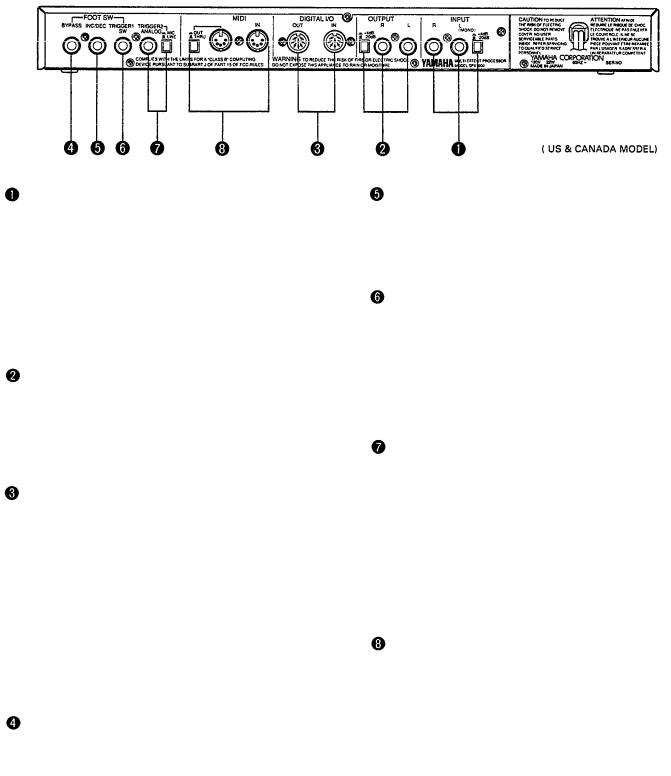
THE CONNECTOR PANEL
L(MONO) & R INPUT Connectors and Level Switch
These are the analog stereo inputs to the SPX1000. The input jacks are standard 1/4” monaural phono types. The level switch selects either -20 dB or +4 dB nominal input level. Please note that the operation of the INPUT jacks depends on the selected INPUT and DIGITAL I/O modes. Refer to “INPUT MODES” and DIGITAL I/O MODES” on page 6 for details.
When an input mode has not been selected and only one input is being used, input is through L(MONO).
L & R OUTPUT Connectors and Level Switch
The stereo analog outputs from the SPX1000. The output jacks are standard l/4” monaural phono types. The level switch selects either -20 dB or +4 dB nominal output level. Please note that the operation of the OUTPUT jacks depends on the selected DIGITAL I/O mode. Refer to “DIGITAL I/O MODES” on page 7 for details.
DIGITAL IN and OUT Connectors
These are the SPX1000’s stereo digital inputs and outputs. All digital data is handled in Yamaha format. The DIGITAL IN and OUT connectors are directly compatible with other Yamaha equipment that provides digital I/O capability – the DMP7D Digital Mixing Processor and DEQ7 Digital Equalizer are excellent examples. The Yamaha FMC1 Format Converter can also be used to convert the SPX1000’s digital output to virtually all popular digital formats, allowing direct connection to standard digital recorders, etc. Please note that the operation of the DIGITAL IN and OUT jacks depends on the selected DIGITAL I/O mode. Refer to “DIGITAL I/O MODES” on page 7 for details.
BYPASS Footswitch Jack
An optional Yamaha FC5 footswitch or equivalent connected to this jack can be used for foot control of the BYPASS function.
• Details on page 9
INC/DEC Footswitch Jack
An optional Yamaha FC5 footswitch or equivalent connected to this jack can be used to recall a range of programs specified by the UTILITY mode F.SW MEMORY RECALL RANGE function.
• Details on page 34
TRIGGER 1 SW Footswitch Jack
The TRIGGER 1 SW footswitch jack accepts a Yamaha FC5 or equivalent footswitch for foot-controlled triggering of any SPX1000 effect program that has trigger parameters. The reverb programs, for example, include a triggerable gate, and the freeze programs allow triggering of recording and playback. A footswitch connected to the TRIGGER 1 SW jack has the same function as the frontpanel TRIGGER key (THE FRONT PANEL, 14).
TRIGGER 2 ANALOG Jack & MIC/LINE Switch
The triggerable SPX1000 effect programs (gate programs, freeze programs, etc.) can be triggered by the front-panel TRIGGER key, a footswitch connected to the TRIGGER 1 SW jack, or an input signal appearing at the INPUT L and R or DIGITAL IN connectors. The TRIGGER 2 ANALOG jack offers a fourth triggering method: triggering can be accomplished by applying an analog signal of sufficient amplitude to this jack. The MIC/LINE switch changes the sensitivity of the TRIGGER 2 ANALOG input to accept microphone or line-level signals.
MIDI IN and THRU/OUT Terminals
MIDI signals from external MIDI devices can be fed to the MIDI IN terminal to remotely select effects, set the pitch shift of the pitch change effects and set the pitch of freeze-program playback. When the switch controlling the remaining MIDI terminal is set to THRU, the terminal simply re-transmits data received at the MIDI IN terminal allowing daisy-chaining of MIDI devices. When set to OUT, the internal RAM memory contents may be dumped to a MIDI data recorder for large-volume, longterm storage. Program data thus stored can be reloaded later via the MIDI IN terminal (see BULK OUT 1 & BULK OUT 2 on page 33).
5
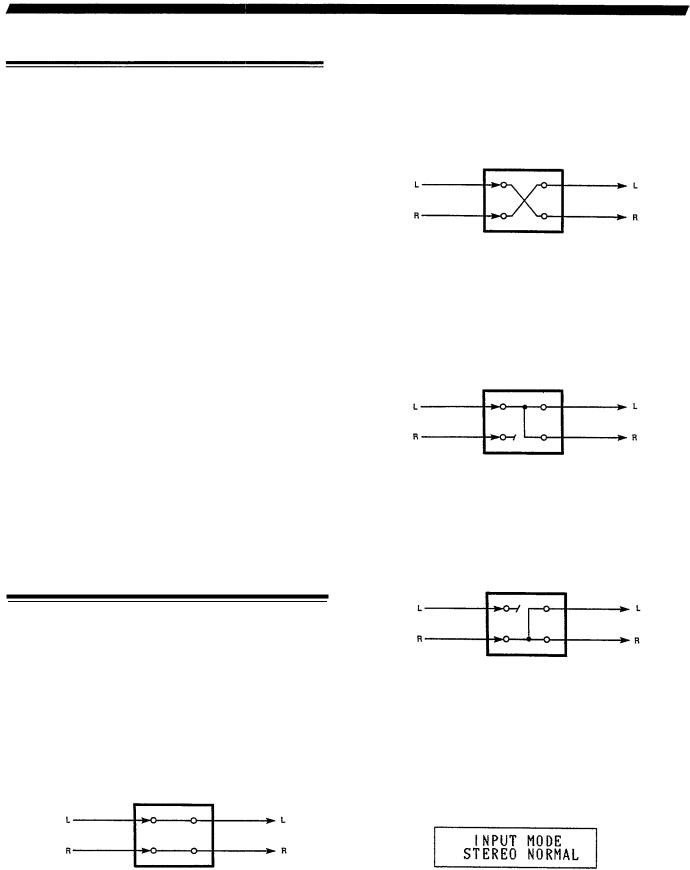
2: THE SPX1000 SYSTEM
MEMORY CONFIGURATION
The SPX1000 has a total of 99 internal memory locations. Locations 1 through 40 are READ-ONLY MEMORY containing 40 preset effect programs. These locations cannot be written to or changed in any way. The preset effect programs contained in memory locations 1 through 40 are:
1. |
REV 1 HALL |
21. PITCH CHANGE 2 |
|
2. |
REV 2 ROOM |
22. |
PITCH CHANGE 3 |
3. |
REV 3 VOCAL |
23. |
FREEZE 1 |
4. |
REV 4 PLATE |
24. |
FREEZE 2 |
5. |
REVS ECHO ROOM |
25. |
PAN |
6. |
EARLY REF. 1 |
26. |
TRIGGERED PAN |
7. |
EARLY REF. 2 |
27. |
DISTORTION |
8. |
EARLY REF. 3 |
28. |
MULTI (CHO&REV) |
9. |
GATE REVERB |
29. |
MULTI (SYM+REV) |
10. |
REVERSE GATE |
30. |
MULTI (EXC&REV) |
11. |
DELAY L,C,R |
3 1. |
PLATE + HALL |
12. |
STEREO ECHO |
32. |
ER + REV |
13. STEREO FLANGE A |
33. ECHO + REV |
||
14. STEREO FLANGE B |
34. CHORUS + REV |
||
15. CHORUS |
35. PAN + PAN |
||
16. STEREO PHASING |
36. COMPRESSOR |
||
17. TREMOLO |
37. LO LVL EXPANDER |
||
18. SYMPHONIC |
38. |
EXCITER |
|
19. ADR-NOISE GATE |
39. STEREO PITCH |
||
20. PITCH CHANGE 1 |
40. STEREO FREEZE |
||
Locations 41 through 99 are READ/WRITE MEMORY which can be used to store your own edited versions of the preset programs.
INPUT MODE AND DIGITAL I/O
CONFIGURATIONS
The SPX1000 offers a choice of input modes as well as analog and digital input/output configurations, providing extraordinary flexibility in “adapting” to various systems and requirements.
INPUT MODES
The SPX1000 offers the following input modes, regardless of the selected DIGITAL I/O mode:
STEREO NORMAL
This is the normal mode of operation in which leftand rightchannel signals received at the leftand right-channel inputs are passed on to the SPX1000 processing circuitry on the same channels as which they were received.
STEREO REVERSE
In this input mode the received leftand right-channel signals are switched to the opposite channels. The left-channel input is fed to the right-channel processing circuitry and the rightchannel input signal is fed to the left-channel processing circuitry.
MONO LEFT
This and the MONO R mode described below are ideal for use with monaural input signals. In the MONO L mode a monaural signal received at the INPUT L jack is fed to both the leftand right-channel processing circuitry.
MONO RIGHT
A monaural signal received at the INPUT R jack is fed to both the leftand right-channel processing circuitry.
Selecting an Input Mode
Input modes are selected using the utility-mode INPUT MODE function.
1.Press the UTILITY key twice to call the INPUT MODE function.
6
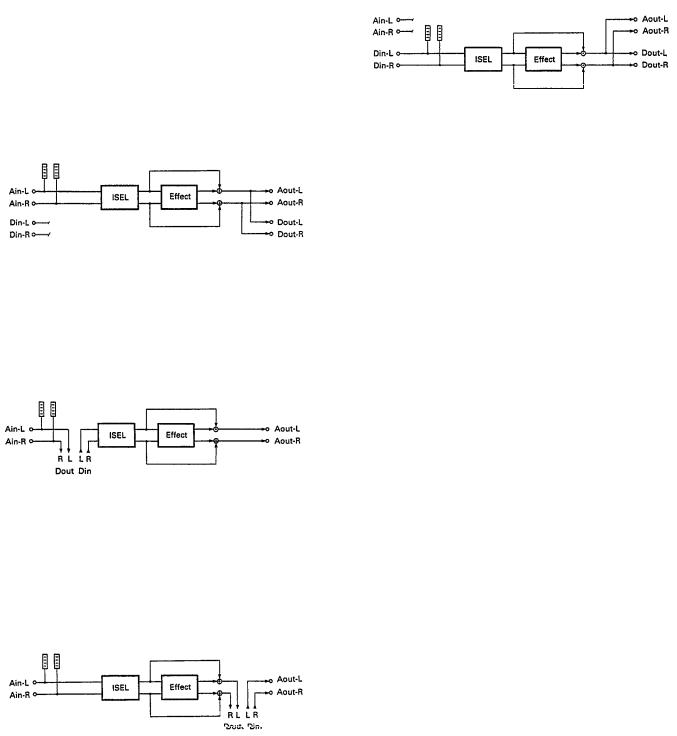
2.Use the parameter select  and
and keys to select the desired input mode. The name of the selected input mode should
keys to select the desired input mode. The name of the selected input mode should
now be flashing on the LCD.
3.Press the STORE key to activate the selected input mode. The name of the selected mode will stop flashing and the corresponding INPUT MODE indicator LED will light (ST NORMAL, ST REVERSE, MONO L or MONO R).
4.Press and hold the UTILITY key until its indicator goes out and the utility mode is exited.
DIGITAL I/O MODES
The SPX1000 has the following DIGITAL I/O modes which determine the operation of its analog and digital inputs and outputs.
ANALOG
In this mode the DIGITAL IN connector is inactive and the SPX1000 receives input via the analog INPUT L and R jacks. Both the analog OUTPUT L and R and DIGITAL OUT connectors are active so that the SPX1000’s output can be simultaneously fed to analog and digital equipment if required.
PRE(lNSERT PRE)
In this mode the SPX1000 receives input via the analog INPUT L and R jacks. The DIGITAL IN and OUT jacks function as a pre-effect insert point, allowing a second SPX1000 or other Yamaha-format digital device to be inserted into the signal path prior to both the input selector and effect processor. Output is delivered via the analog OUTPUT L and R jacks.
POST(INSERT POST)
In this mode the SPX1000 receives input via the analog INPUT L and R jacks. The DIGITAL IN and OUT jacks function as a post-effect insert point, allowing a second SPX1000 or other Yamaha-format digital device to be inserted into the signal path after the effect processor. Output is delivered via the analog OUTPUT L and R jacks.
DIGITAL(DIGlTAL ONLY)
In this mode the analog INPUT L and R jacks are inactive and the SPX1000 receives input via the DIGITAL IN connector. Both the analog OUTPUT L and R and DIGITAL OUT connectors are active so that the SPX1000’s output can be simultaneously fed to analog and digital equipment if required.
Selecting a DIGITAL l/O Mode
DIGITAL I/O modes are selected using the utility-mode A/D I/O MODE function.
1.Press the UTILITY key three times to call the A/D I/O MODE function.
This function has two parameters: MODE and CLK (clock). The MODE parameter can be set to any of the four DIGITAL I/O modes described above: ANA (Analog), PRE, PST (Post), or DIG (Digital). When the DIG, PRE or PST mode is selected, the CLK parameter can be set to INT (Internal) or EXT (External), determining whether the digital clock signal is derived from the SPX1000’s own internal clock generator (INT) or the clock signal included in the digital input signal received via the DIGITAL IN connector (EXT). When the ANA mode is selected the CLK parameter is fixed at INT.
2.Use the parameter select  and
and  keys to select the desired DIGITAL I/O MODE. The name of the selected mode should now be flashing on the LCD.
keys to select the desired DIGITAL I/O MODE. The name of the selected mode should now be flashing on the LCD.
3.If necessary, press the PARAM key to move the underline cursor to the CLK parameter and use the
key to move the underline cursor to the CLK parameter and use the
parameter select and
and keys to select the desired CLK setting. The SCROLL BACK
keys to select the desired CLK setting. The SCROLL BACK  key can be used to move
key can be used to move
the underline cursor back to the MODE parameter if necessary.
4. Press the STORE key to activate the selected DIGITAL I/O mode and CLK setting. The name of the selected mode will stop flashing and the corresponding DIGITAL I/O indicator LED will light (INSERT PRE, INSERT POST or DIGITAL ONLY). None of the DIGITAL I/O indicators will light if the ANA mode is selected.
7
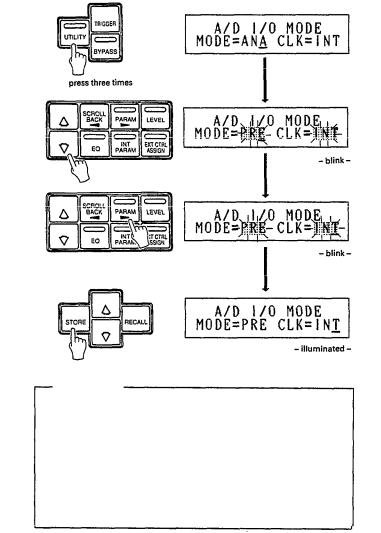
5.Press and hold the UTILITY key until its indicator goes out and the utility mode is exited.
CAUTION!
When the SPX1000 clock (CLK) mode is switched from internal (INT) to external (EXT), or vice-versa, a noise pulse may appear at the outputs. This also occurs if the SPX1000 is switched from digital to analog input while CLK is set to EXT (CLK is automatically reset to INT in this case).
Be sure to lower the volume level of equipment connected to the SPX1000 outputs when performing any of above operations.
8
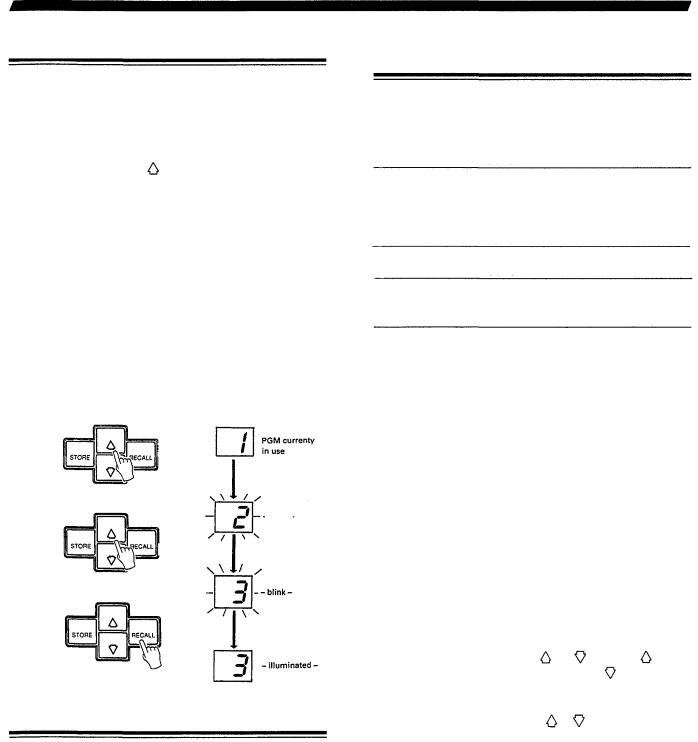
3: GENERAL OPERATION
SELECTING AN EFFECT/MEMORY LOCATION
1.Effects and memory locations can only be selected when the utility mode is not active (the UTILITY KEY indicator is not lit). If the UTILITY key indicator is lit, press and hold the UTILITY key until its indicator goes out and the utility mode is exited.
2. Press the program select or  key to increment or decrement the memory location number shown on the LED display. Hold either of these keys down for continuous incrementing or decrementing. The name of the program corresponding to the currently selected memory location will be shown on the LCD, or "*** NO DATA ***" will be displayed if a memory location between 41 and 99 is selected into which an edited effect program has not been stored. Note that at this stage the LED memory number display is flashing, indicating that although a new location has been selected, its contents have not yet been recalled.
key to increment or decrement the memory location number shown on the LED display. Hold either of these keys down for continuous incrementing or decrementing. The name of the program corresponding to the currently selected memory location will be shown on the LCD, or "*** NO DATA ***" will be displayed if a memory location between 41 and 99 is selected into which an edited effect program has not been stored. Note that at this stage the LED memory number display is flashing, indicating that although a new location has been selected, its contents have not yet been recalled.
3.When the desired memory location/effect has been selected, press the RECALL key. The LED memory number display will stop flashing and the selected effect will be engaged.
- blink -
BYPASSING THE EFFECT
There are two ways to switch the selected effect in and out: 1) with the control panel BYPASS switch and 2) with a footswitch connected to the connector-panel BYPASS footswitch jack. An optional Yamaha FC5 Footswitch can be used for foot-bypass control. In either case + when the control-panel BYPASS key or BYPASS footswitch is pressed + the LED in the BYPASS key will light to indicate that the selected program is currently being bypassed and the input signal is directly routed to the output terminals (i.e. the effect is OFF). Press the BYPASS key or footswitch a second time to turn off the BYPASS Key LED and turn the effect back ON.
ACCESSING & EDITING
THE PROGRAM PARAMETERS
Each SPX1000 program has 4 different groups of parameters which are accessed by pressing the corresponding parameter select keys:
KEY |
ACCESSES |
PARAM |
The main effect parameters for each program. |
|
These parameters will vary according the type |
|
of program. |
LEVEL |
The BALANCE and OUT LVL parameters for |
|
each program. |
EQ |
The equalization or dynamic filter parameters |
|
for each program. |
INT. PARAM. Special "fine control" parameters for each program. These parameters will vary according to the type of program.
To call a specific group of parameters for the currently selected effect program, press the appropriate parameter select key. The next parameter within the group is called each time the parameter select key for that group is pressed. In any parameter group, the SCROLL BACK key can be used to scroll backwards through the parameters. For example, subsequent presses on the LEVEL parameter select key call the following parameters:
BALANCE -> OUT LVL -> BALANCE -> etc.
The complete procedure for calling and editing parameters is:
1.Select and recall the program to be edited.
2.Press the parameter select key corresponding to the group of parameters to be edited (PARAM, LEVEL, EQ or INT PARAM) and the first of the selected group's parameters will appear on the bottom line of the LCD.
3.Once the desired parameter has been called, its value can
be edited using the parameter |
and |
keys. The key |
|
increases (increments) the value while the |
key decreases |
||
(decrements) the value. Either key can be held down for |
|||
continuousincrementingordecrementing. |
|
||
While holdingdown eitherthe |
or |
key, pressing the |
|
other key ( or
or ) causes the incrementing or decrementing process to be carried out more rapidly.
) causes the incrementing or decrementing process to be carried out more rapidly.
9
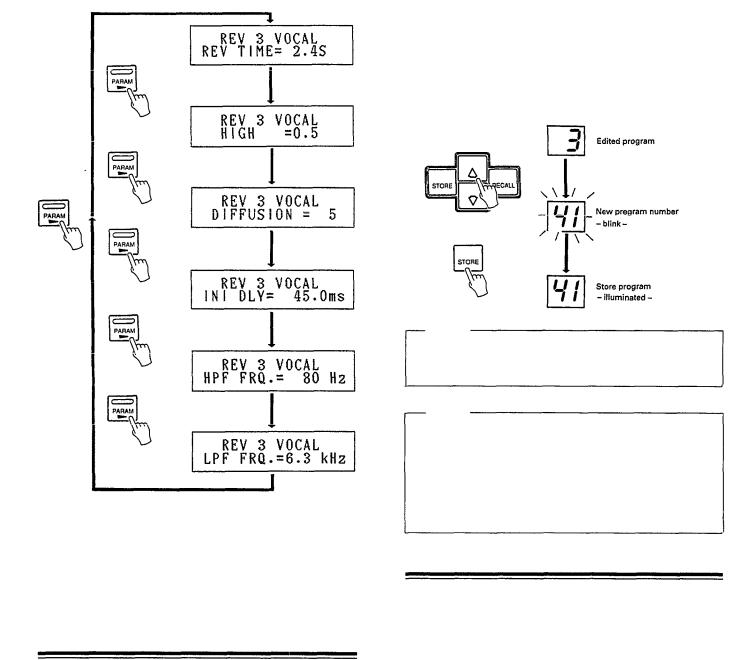
3.Press the STORE key to store the edited effect in the selected memory location. The title of the effect stored will appear on the LCD (this may later be edited to create your
own effect title using the UTILITY mode TITLE EDIT function described on page 31). The LED memory number display will stop flashing and the stored memory location will become the active effect.
In this way you can go through and edit any number of the parameters to create the required effect. If, however, you select and recall a new program without first storing your edited parameters in a memory location between 41 and 99, any changes you have made will be lost and will have to be re-programmed. If you want to keep an edited program, use the STORE operation described below.
STORING EFFECTS
In order to store an edited effect for later recall you need to do the following:
1.Make sure that the SPX1000 MEMORY PROTECT function is OFF. Press the UTILITY key a few times until
the MEMORY PROTECT function appears. If it is ON, press the parameter key to turn it OFF. Press and hold the UTILITY key until its indicator goes out and the utility mode is exited.
key to turn it OFF. Press and hold the UTILITY key until its indicator goes out and the utility mode is exited.
2.After editing the effect. select a memory location between
41 and 99 by using the program select and
and keys. Do not recall the selected memory location. If an edited program has previously be stored in the selected memory location. its title will be displayed on the LCD.
keys. Do not recall the selected memory location. If an edited program has previously be stored in the selected memory location. its title will be displayed on the LCD.
NOTE:
You CANNOT store edited data to memory locations 1 through 40. If you attempt to do this the LCD will show “*** READ ONLY ***”.
NOTE:
Once an effect has been stored in a memory location between 41 and 99, its parameters can be further edited in the new memory location. Such changes will be lost if a different effect is selected and recalled, however, unless the STORE function is used to store the changes. Changes may be stored to the current memory location number (41 – 99) simply by pressing the STORE key.
EXTERNAL CONTROL ASSIGNMENT
The SPX1000 allows two different parameters of a selected effect to be controlled by optional foot controllers (Yamaha FC7) connected to the front-panel EXT CTRL/FOOT VOL1 and 2 jacks. The EXT CTRL ASSIGN key is used to assign the desired effect parameters to the foot controllers used, and to set the required control range. External control assignments made for an effect program can be stored in the user memory area (41 – 99) along with the effect (using the STORE function described above), so that the assignments made are recalled whenever that memory location is selected.
1.Select the desired effect program.
2.Select the parameter to be assigned to an external foot controller (PARAM, LEVEL, EQ or INT PARAM parameters can be assigned).
3.Press the EXT CTRL ASSIGN key. The name of the selected effect program will remain on the upper line of the LCD, and one of the following parameters will appear on the lower line:
10
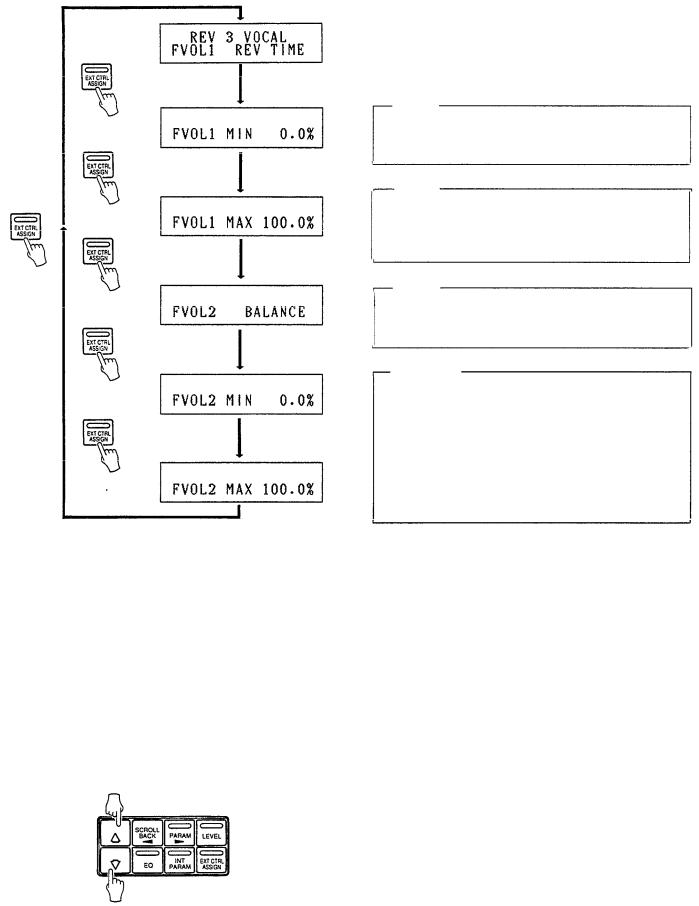
In the actual display, “XXXXXXXX” will be the name of the default parameter for the selected effect program. The EXT CTRL ASSIGN key can be used to scroll forward through the above parameters, and the SCROLL BACK key can be used to scroll backwards.
4.To assign the selected parameter to the EXT CTRL/FOOT VOL 1 or EXT CTRL/FOOT VOL 2 controller, use the EXT CTRL ASSIGN or SCROLL BACK key to call the “FVOL1 XXXXXXXX” or “FVOL2 XXXXXXXX” parameter.
5.Press either the parameter  or
or  key and the parameter you called within the selected effect program will be assigned to the foot controller indicated on the display
key and the parameter you called within the selected effect program will be assigned to the foot controller indicated on the display
(FVOL 1 or FVOL 2).
6.Use the “MIN” and “MAX” parameters for the appropriate controller to set the control range. If the parameter to be controlled has a range of 0 to 100%, for example, setting the MIN parameter to 20 and the MAX parameter to 80 will allow the foot controller to vary the selected parameter from 20% to 80% of its total range.
NOTE:
Either or both controllers may be assigned. When both controllers are used, each can be assigned a different parameter within the selected effect program.
NOTE:
External control assignments will be lost if a different memory location is selected without first storing the assigned effect program into one of the user memory locations (41 — 99) using the STORE function..
NOTE:
MIDI control change messages received via the MIDI IN connector can also be used to control assigned parameters. See “MIDI CTRL ASSIGN” on page 63.
CAUTION!
When setting the range and storing it in the program, always make sure the preset values for the assigned parameters are included within the set range.
When setting the range, confirm the values for MIN and MAX with the controller, and always make sure the preset values are inside the externally set values.
If the preset values are outside the specified range, there may be no response to the controller when a recall operation is carried out.
11
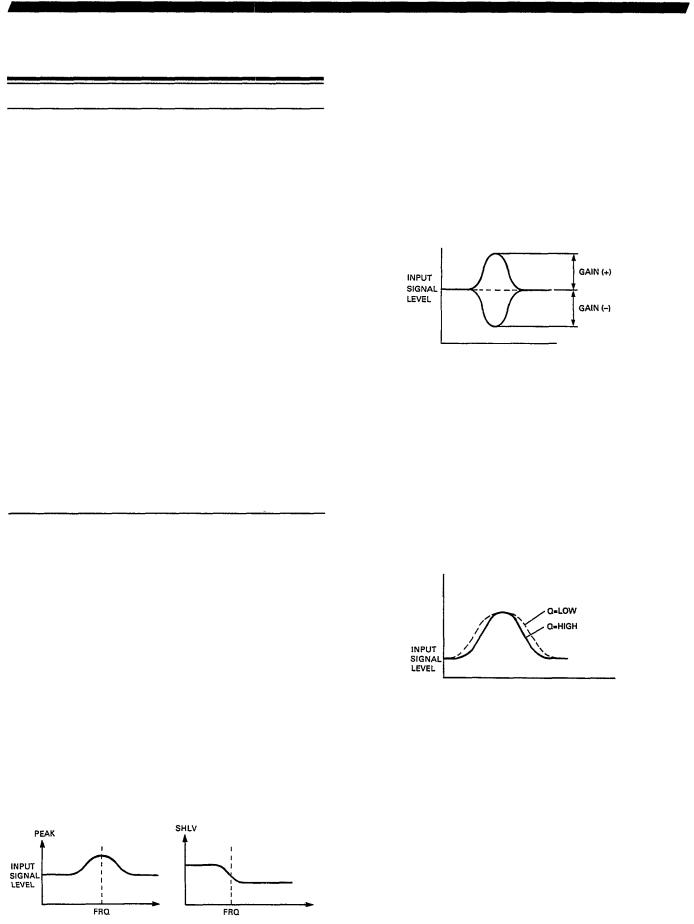
4: THE PROGRAMS & PARAMETERS
PARAMETERS PROVIDED
FOR ALL PROGRAMS
LEVEL PARAMETERS (Accessed via LEVEL key)
Effect/Direct Signal Balance (BALANCE): 0 – 100%
This parameter adjusts the balance between the direct sound and effect signals. At 100% only the effect sound is delivered from the SPX1000 outputs, while at 0% only the direct sound is output. At a setting of 50%, the direct and effect sounds are output in approximately equal proportions.
Effect Output Level (OUT LVL): 0 – 200%
This parameter sets the overall output level of the effect program. This is particularly handy for matching levels between different effects.
2-CHANNEL PROGRAM (PROGRAMS 31 – 35) LEVEL PARAMETERS
The level parameters available for the 2-channel programs (programs 3 1 – 35) are the same as those for the other programs, except that separate parameters are provided for the left and right channels.
BALANCE 1 = 1 (Left)-channel Balance BALANCE 2 = 2 (Right)-channel Balance OUT LVL 1 = 1 (Left)-channel Output Level OUT LVL 2 = 2 (Right)-channel Output Level
EQ PARAMETERS (Accessed via EQ key)
When the EQ key is pressed, you are presented with three choices: “OFF” (the default setting), “EQ” (2-band parametric equalizer mode), or “D.FLT” (Dynamic Filter mode). Use the parameter  and
and  keys to select the desired mode of operation. The EQ mode provides 2-band parametric equalization, while the Dynamic Filter mode provides a filter which can be automatically swept across a specified frequency range by the SPX1000’s internal low frequency oscillator or the level of the input signal.
keys to select the desired mode of operation. The EQ mode provides 2-band parametric equalization, while the Dynamic Filter mode provides a filter which can be automatically swept across a specified frequency range by the SPX1000’s internal low frequency oscillator or the level of the input signal.
 PARAMETERS AVAILABLE IN THE “EQ" MODE
PARAMETERS AVAILABLE IN THE “EQ" MODE
Low EQ Peaking or Shelving Response (LOW EQ.): PEAK, SHLV
High EQ Peaking or Shelving Response (HIGH EQ): PEAK, SHLV
These parameters determine whether the corresponding band has a peaking or shelving filter response.
Low EQ Frequency (LOW FRQ): 32 Hz – 2.2 kHz High EQ Frequency (HIGH FRQ): 500 Hz – 16 kHz
These parameters determine the center frequency for equalization in the corresponding band. In the shelving mode, these parameters represent the turn over frequency rather than the center frequencies.
Low EQ Gain (LOW GAIN): -15 – + 15 dB High EQ Gain (HIGH GAIN): -15 – + 15 dB
These parameters determine the amount of boost or cut applied to the corresponding EQ band.
Low EQ Bandwidth (LOW Q): 0.1 – 5.0 (PEAK mode only)
High EQ Bandwidth (HI Q): 0.1 – 5.0 (PEAK mode only)
These parameters determine the bandwidth of the corresponding EQ band. A setting of 5.0 produces the narrowest bandwidth (sharpest response), and the minimum setting of 0.1 produces the widest bandwidth (broadest response). Note that the “Q” parameters for the low and high bands only function when the corresponding band is set to the PEAK mode.
 PARAMETERS AVAILABLE IN THE “D.FLT” MODE
PARAMETERS AVAILABLE IN THE “D.FLT” MODE
Control Type (CTL TYPE): LFO, LEVEL
Determines whether the sweep of the dynamic filter is controlled by the SPX1000’s LFO (Low Frequency Oscillator) or the level of the input signal to analog trigger.
12
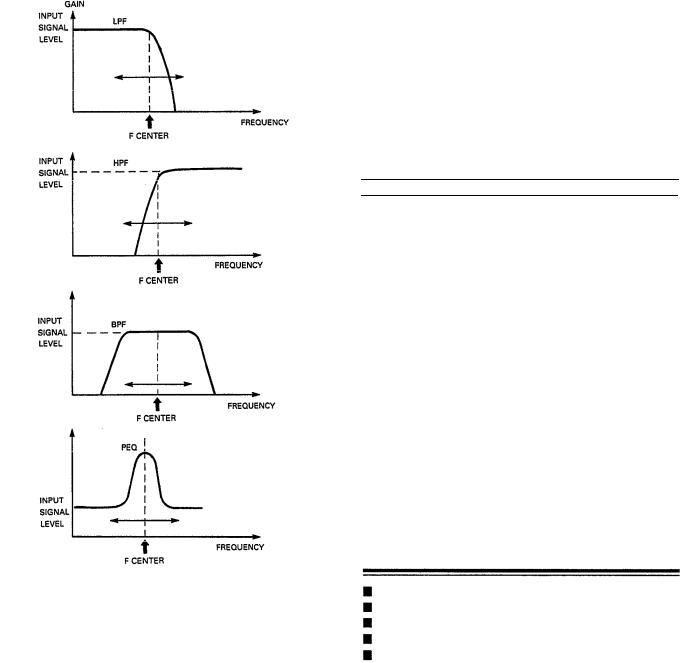
Filter Type (FLT TYPE): LPF, HPF, BPF, PEQ
Determines the response of the dynamic filter:
LPF = Low Pass Filter
HPF = High Pass Filter
BPF = Band Pass Filter
PEQ = Parametric EQ
Center Frequency (F CENTER): 32 Hz – 16 kHz
Sets the starting center frequency of the dynamic filter.
Frequency Depth (F DEPTH): 0 – 8 octaves
Determines the maximum sweep range of the dynamic filter.
Filter Gain (GAIN): -18, -12, -6, 6, 12, 18 dB (when FLT TYPE = PEQ only)
Determines the gain of the dynamic filter when the PEQ filter type is selected. Minus values create a notch response while positive values create a peaking response.
Bandwidth (Q): LOW, HIGH
Sets the bandwidth of the dynamic filter.
Filter Shift Direction (SHIFT): UP, DOWN
Determines which direction the dynamic filter will sweep in from the starting point.
Filter Sensitivity (SENSITIVITY): 1 – 10
Adjusts the sensitivity of the dynamic filter. Higher settings create a greater degree of sweep for the same change in input level (LEVEL control type).
Filter Decay (DECAY): 1 – 10
Determines the speed at which the dynamic filter will return to the starting frequency after activation.
Low Frequency Oscillator Frequency (LFO FRQ): 0.1
– 10.0 Hz
Sets the LFO frequency and thus the speed of dynamic filter sweep when the LFO control type is selected.
2-CHANNEL PROGRAM (PROGRAMS 31 – 35) EQ
PARAMETERS
The EQ parameters for the 2-channel programs (programs 31
– 35) are the same as for the other programs, except that separate EQ parameters are provided for the left and right channels when the “EQ” mode is selected.
L LOW EQ = Left-channel Low EQ
L LOW F = Left-channel Low Frequency
L LOW G = Left-channel Low Gain
L LOW Q = Left-channel Low Bandwidth
L HI EQ = Left-channel High EQ
L HI F = Left-channel High Frequency
L HI G - Left-channel High Gain
L HI Q = Left-channel High Bandwidth
R LOW EQ = Right-channel Low EQ
R LOW F = Right-channel Low Frequency
R LOW G = Right-channel Low Gain
R LOW Q = Right-channel Low Bandwidth
R HI EQ = Right-channel High EQ
R HI F = Right-channel High Frequency
R HI G - Right-channel High Gain
R HI Q = Right-channel High Bandwidth
REVERB PROGRAMS
1.REV1 HALL
2.REV2 ROOM
3.REV3 VOCAL
4.REV4 PLATE
5.REV5 ECHO ROOM
Reverberation is the warm musical “ambience” you experience when listening to music in a hall or other properlydesigned acoustic environment. The SPX1000 offers several different reverb effects, simulating types of reverberation you would experience in a hall (REV 1 HALL), in a smaller room (REV 2 ROOM), a reverb effect ideally suited to vocals (REV 3 VOCAL), the type of reverberation produced artificially by
13

a plate reverberator (REV 4 PLATE), and a special echo room (REV 5 ECHO ROOM) in which you have extensive control over the room’s dimensions and other parameters.
PARAMETERS ACCESSED BY THE PARAM KEY
(Except 5. REV5 ECHO ROOM)
Reverb Time (REV TIME):
0.3 – 480 seconds (1 REV1 HALL, 3 REV3 VOCAL) 0.1 –480 seconds (2 REV2 ROOM, 4 REV4 PLATE)
The length of time it takes for the level of reverberation at 1 kHz to decrease by 60 dB + virtually to silence. In a live setting, this depends on several factors: room size, room shape, type of reflective surfaces, and others.
High Frequency Reverb Time Ratio (HIGH): 0.1 – 1.0
Natural reverberation varies according to the frequency of the sound. The higher the frequency, the more sound tends to be absorbed by walls, furnishings and even air. These two parameters allow alteration of the high-frequency and lowfrequency reverb times in relation to the overall reverb time.
Diffusion (DIFFUSION): 0 – 10
The complexity of the many reflections that make up reverberation varies according to the shape of the room and its contents. In the SPX1000 the term “diffusion” refers to the complexity of these reflections. If the DIFFUSION parameter is set to “0,” minimum complexity and therefore a clearer, more straightforward reverb effect is produced. As the DIFFUSION value is increased, the complexity of the reflections increases producing a thicker, richer sound.
Initial Delay (INI DLY): 0.1 – 1000 milliseconds
This represents the time delay between the direct sound of an instrument in a concert hall and the first of the many reflections that make up reverberation.
High-pass Filter Frequency (HPF FRQ): THRU, 32 Hz
– 1 kHz
Permits rolling off the low-frequency content of the reverb signal above the set frequency. The HPF is OFF when set to THRU.
Low-pass Filter Frequency (LPF FRQ): 1 – 16 kHz, THRU
Permits rolling off the high-frequency content of the reverb signal above the set frequency. The LPF is OFF when set to THRU.
 5. REV5 ECHO ROOM
5. REV5 ECHO ROOM
Reverb Time (REV TIME): 0.3 – 480 seconds
The length of time it takes for the level of reverberation at 1 kHz to decrease by 60 dB + virtually to silence. In a live setting, this depends on several factors: room size, room shape, type of reflective surfaces, and others.
Room Width (WIDTH): 0.5 – 100.0 meters Room Height (HEIGHT): 0.5 – 100.0 meters Room Depth (DEPTH): 0.5 – 100.0 meters
These parameters make it possible to specify the main dimensions of the echo room in meters. Basically, the larger the dimensions of the room the longer the reverb sound.
Wall Variance (WALL VARY): 0 – 30
Irregularity factor refers to the relationship of the wall surfaces in the echo room. At a setting of 1 all walls are parallel. Higher settings increase the angles between the wall surfaces, causing a distinct change in the reverb sound.
Listening Position (LIS. POSI.): FRONT, CENT., REAR
Allows position the “listener” to the front, center or rear of the echo room in relation to the source sound.
High Frequency Reverb Time Ratio (HIGH): 0.1 – 1.0
Natural reverberation varies according to the frequency of the sound. The higher the frequency, the more sound tends to be absorbed by walls, furnishings and even air. These two parameters allow alteration of the high-frequency and lowfrequency reverb times in relation to the overall reverb time.
Diffusion (DIFFUSION): 0 – 10
The complexity of the many reflections that make up reverberation varies according to the shape of the room and its contents. In the SPX1000 the term “diffusion” refers to the complexity of these reflections. If the DIFFUSION parameter is set to “0,” minimum complexity and therefore a clearer, more straightforward reverb effect is produced. As the DIFFUSION value is increased, the complexity of the reflections increases producing a thicker, richer sound.
Initial Delay (INI DLY): 0.1 – 1000 milliseconds
This represents the time delay between the direct sound of an instrument in a concert hall and the first of the many reflections that make up reverberation.
High-pass Filter Frequency (HPF FRQ): THRU, 32 Hz
– 1 kHz
Low-pass Filter Frequency (LPF): 1 – 16 kHz, THRU
Same as other reverbs.
14

Width fine: -100 – +100
This sets the value specified with WIDTH as the reference value (0) and is the parameter for fine adjustment.
Height Fine: -100 – +100
This sets the value specified with HEIGHT as the reference value (0) and is the parameter for further fine adjustment.
Depth Fine: -100 – +100
This sets the value specified with DEPTH as the reference value (0) and is the parameter for further fine adjustment.
Wall Vary Fine (W. VARY FINE): -100 – +100
This sets each of the value specified with WIDTH, HEIGHT, DEPTH, and WALL VARY as the reference value (0) and is the parameter for further fine adjustment.
W. Decay: RT x 0.1 – 1.0
Among the REV components, this sets the reverberation time of the REV components specified with WIDTH to a multiplier value corresponding to the REV TIME. It simulates the acoustic properties of the side walls.
H.Decay: RT x 0.1 – 1.0 D. Decay: RT x 0.1 – 1.0
In the same way as for W. Decay, this sets a multiplier value corresponding to REV TIME for reverberation time felt in relation to the HEIGHT (vertical direction) in the height direction and that felt for the DEPTH in the front-to-back direction. It also simulates the acoustic properties of the walls in the vertical and front-to-back disrections.
PARAMETERS ACCESSED BY THE INT PARAM KEY
Early Reflection/Reverb Balance (ER/REV BAL.): 0 – 100%
This parameter determines the level balance between the early-reflection portion and final reverberation portion of the reverb sound. At 100% only the early-reflection sound will be produced. At 0% only the final reverberation sound will be produced. A setting of about 50% produces both the earlyreflection and final reverberation sounds at equal level.
Reverb Delay (REV DLY): 0.1 – 300.0 milliseconds
Sets the delay between the beginning of the early reflections
– the initial group of sparse reflections that precede the dense reverb sound – and the beginning of the reverb sound.
Density (DENSITY): 0 – 4
This parameter determines the density of the reverb reflections (i.e. the average amount of time between reflections). A setting of 1 produces minimum reverb density for a more spacious sound, while a setting of 4 produces the most dense, “tightest” reverberation.
Trigger Level (TRG. LEVEL): 0 – 100%
Determines the level of the input signal required to trigger “opening” of the reverb program gate. At 100% only very high-level input signals will trigger the gate, while at 1% even the tiniest input signal will trigger the gate.
Trigger Delay (TRG. DLY): -100 – +100 milliseconds
Produces a delay between the time at which the gate is triggered and that at which it actually opens.
Hold Time (HOLD): 1 – 24,000 milliseconds
Determines how long the gate stays open, allowing the signal to pass.
Release Time (RELEASE): 3 – 24,000 milliseconds
Determines how long it takes for the gate to close fully after the HOLD TIME has ended.
Analog Trigger Level (A. TRG LVL): 0 – 100
When an analog signal applied to the rear-panel TRIGGER 2 ANALOG jack is used to trigger the gate, this parameter determines the level of the input signal required to trigger “opening” of the reverb program gate. At 100% only very high-level input signals will trigger the gate, while at 1% even the tiniest input signal will trigger the gate. When this function is used the TRG. LEVEL parameter should be set to the highest value (100%) so that only signals applied to the TRIGGER 2 ANALOG jack will activate the gate.
MIDI Trigger (MIDI TRG.): OFF, ON
When this parameter is turned ON, a KEY ON EVENT message from an external MIDI keyboard can be used to trigger the gate. A KEY ON EVENT message is transmitted whenever a note on a MIDI keyboard is played.
NOTE:
This effect can also be triggered by the front-panel TRIGGER key or a footswitch plugged into the rear-panel TRIGGER 1 SW jack.
15
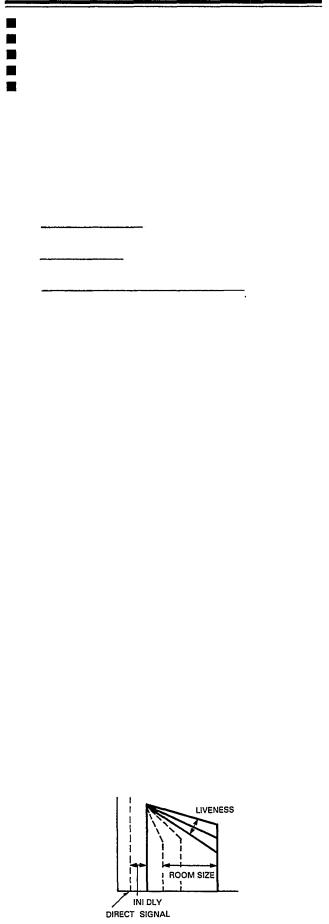
EARLY REFLECTION PROGRAMS
6.EARLY REF. 1
7.EARLY REF. 2
8.EARLY REF. 3
9.GATE REVERB
10.REVERSE GATE
These effects are created using different groupings of “early reflections” – the first cluster of reflections that occurs after the direct sound but before the dense reflections that are known as reverberation begin.
PARAMETERS ACCESSED BY THE PARAM KEY
Early Reflection Pattern Type (TYPE):
EARLY REF. 1 & 2: S-HALL, L-HALL, RANDOM, REVERSE, PLATE, SPRING
EARLY REF. 3: USER-A, USER-B, USER-C, USER-D
GATE REVERB & REVERSE GATE: TYPE A, TYPE B
In the EARLY REF. 1 and EARLY REF. 2 programs the TYPE parameter selects one of six different patterns of early reflections. S-HALL produces a typical grouping of early reflections that would occur in a performing environment such as a small hall. L-HALL simulates the early reflection pattern of a larger hall. RANDOM produces an irregular series of reflections that could not occur naturally. REVERSE generates a series of reflections that increase in level – like the effect produced by playing a recorded reverberation sound backwards. PLATE produces a typical grouping of reflections that would occur in a plate reverb unit, and SPRING produces the same for spring type reverb unit.
In the EARLY REF. 3 program the TYPE parameter selects one of the four user-programmed early reflection patterns: USER-A, USER-B, USER-C or USER-D. The USER early reflection patterns are programmed using the utility-mode “USER ER EDIT” function (see “USER ER EDIT” on page 31 for details).
In the GATE REVERB and REVERSE GATE programs the TYPE parameter selects either TYPE-A or TYPE-B.
Room Size (ROOM SIZE): 0.1 – 25
This parameter sets the time intervals between the early reflections + a feature of natural early reflections which is directly proportional to the size of the room.
Liveness (LIVENESS): 0 – 10
“Liveness” refers to the rate at which the reflected sounds fade. An acoustically “dead” room is simulated by setting this parameter to zero. Increasing the value of this parameter creates an increasingly “live” sound, simulating an increasing area of reflective surfaces in the room.
Diffusion (DIFFUSION): 0 – 10
The complexity of the many reflections that make up reverberation varies according to the shape of the room and its contents. In the SPX1000 the term “diffusion” refers to the complexity of these reflections. If the DIFFUSION parameter is set to “0,” minimum complexity and therefore a clearer, more straightforward early reflection effect is produced. As the DIFFUSION value is increased, the complexity of the reflections increases producing a thicker, richer sound.
Initial Delay (INI DLY): 0.1 – 1000 milliseconds
Initial delay is the time between the beginning of the direct sound and the beginning of the early reflections.
High-pass Filter Frequency (HPF FRQ): THRU, 32 Hz
– 1 kHz
Permits rolling off the low-frequency content of the reverb signal above the set frequency. The HPF is OFF when set to THRU.
Low-pass Filter Frequency (LPF FRQ): 1 – 16 kHz, THRU
Permits rolling off the high-frequency content of the reverb signal above the set frequency. The LPF is OFF when set to THRU.
PARAMETERS ACCESSED BY THE INT PARAM KEY
Number of Early Reflections (ER NUMBER): 1 – 19
This parameter directly sets the number of early reflections produced from 1 to 19.
Feedback Delay (FB DELAY): 0.1 – 26000 milliseconds
Feedback Gain (FB GAIN): -99 – +99%
Feedback High-frequency Ratio (FB HIGH): 0.1 – 1.0
The feedback parameters permit thickening and/or extending the early reflection sound. Feedback causes the early reflections to generate more early reflections of themselves, thus the FB GAIN parameter determines how many times (for how long) the early reflections are repeated. The FB DELAY parameter sets a delay time between the beginning of the original early-reflections and the first of the repeats caused by feedback. Shorter FB DELAY times simply thicken the earlyreflection sound, while longer FB DELAY times can create extended or repeated early reflection effects. FB HIGH determines how much of the high-frequency content of the original early reflections is fed back. The lower the setting, the less of the original high frequencies are fed back. This causes a gradual decrease in high frequency content at each repeat.
16
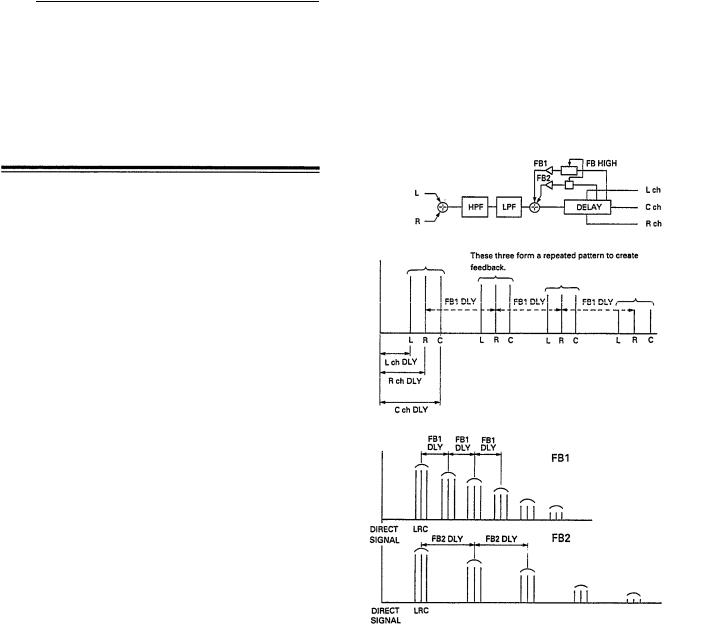
Density (DENSITY): EARLYREF.2: 1 – 3
EARLY REF. 3, GATE REVERB, REVERSE GATE:
0—3
Please note that the DENSITY parameter is not provided in the EARLY REF. 1 program. This parameter determines the density of the reverb reflections (i.e. the average amount of time between reflections). A setting of 0 or 1 produces minimum reverb density for a more spacious sound, while a setting of 3 produces the most dense, “tightest” reverberation.
DELAY PROGRAM
 11. DELAY L,C,R
11. DELAY L,C,R
This sophisticated delay effect offers independently variable left, right and center channel delays.
PARAMETERS ACCESSED BY THE PARAM KEY
Left Channel Delay (Lch DLY): 0.1 – 5200 milliseconds
Right Channel Delay (Rch DLY): 0.1 – 5200 milliseconds
Center Channel Delay (Cch DLY): 0.1 – 5200 milliseconds
These parameters individually set the time between the direct sound of the instrument and the first repeat heard from the left, right and center channels.
Center Channel Level (Cch LVL): -200 – +200%
Adjusts the level of the center-channel delay signal.
PARAMETERS ACCESSED BY THE INT PARAM KEY
High-pass Filter Frequency (HPF FRQ): THRU, 32 Hz
– 1 k H z
Permits rolling off the low-frequency content of the reverb signal above the set frequency. The HPF is OFF when set to THRU.
Low-pass Filter Frequency (LPF FRQ): 1 – 16 kHz, THRU
Permits rolling off the high-frequency content of the reverb signal above the set frequency. The LPF is OFF when set to THRU.
Feedback 1 Delay (FB1 DLY): 0.1 – 5200 milliseconds Feedback 2 Delay (FB2 DLY): 0.1 – 5200 milliseconds
Two separate feedback loops are provided in the delay program, and these parameters determine the amount of delay applied to each feedback signal.
Feedback 1 Gain (FB1 GAIN): -99% – +99% Feedback 2 Gain (FB2 GAIN): -99% – +99%
Set the amount of delay signal fed back to the input of the processor. The higher the feedback gain setting, the greater the number of delayed repeats produced by the corresponding feedback loop.
High Frequency Feedback (HIGH): x0.1 – x1.0
Controls feedback in the high-frequency range. The highfrequency feedback is reduced as the value of this parameter is decreased.
ECHO PROGRAM
 12. STEREO ECHO
12. STEREO ECHO
The stereo echo effect offers independently variable left and right channel initial delays and echo intervals.
PARAMETERS ACCESSED BY THE PARAM KEY
Left Channel Feedback Delay (LFB DLY): 0.1 – 2600 milliseconds
Right Channel Feedback Delay (RFB DLY): 0.1 – 26000 milliseconds
17
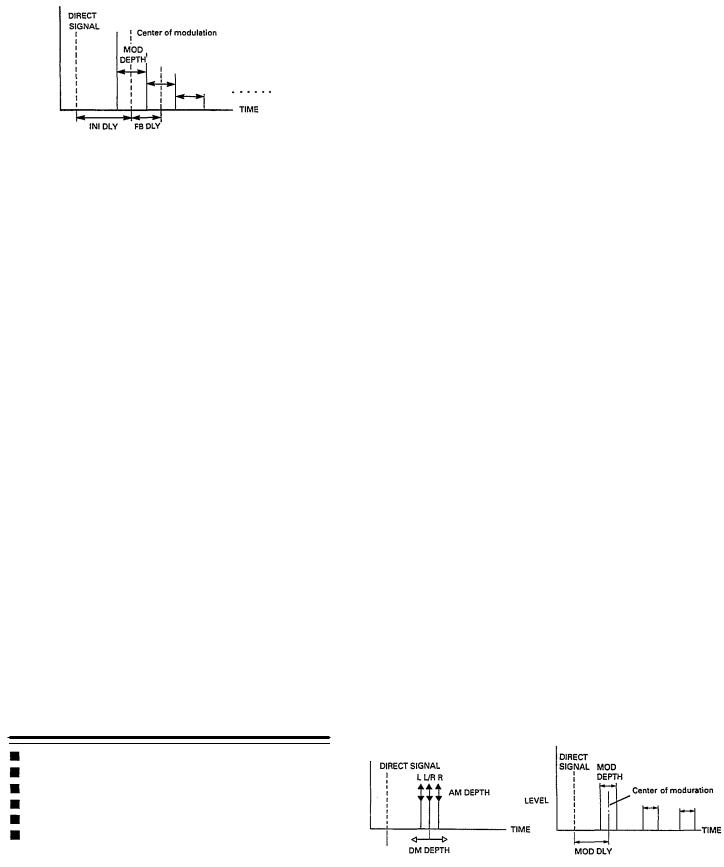
After the initial delay produced by the INI DLY parameters, the time between subsequent repeats is determined by the left and right channel interval parameters.
Left Channel Feedback Gain (Lch F.B): -99% — +99% Right Channel Feedback Gain (Rch F.B): -99% — +99%
Individually set the amount of the left or right channel delay signal fed back to the input of the processor. The higher the feedback gain setting, the greater the number of delayed repeats produced for the corresponding channel.
High Frequency Feedback (HIGH): x0.1 — x1.0
Controls feedback in the high-frequency range. The highfrequency feedback is reduced as the value of this parameter is decreased.
PARAMETERS ACCESSED BY THE INT PARAM KEY
Left Channel Initial (L INI DLY): 0.1— 2600 milliseconds
Right Channel Initial (R INI DLY): 0.1— 2600 milliseconds
These parameters individually set the time between the direct sound of the instrument and the first repeat heard from the left and right channels.
High-pass Filter Frequency (HPF FRQ): THRU, 32 Hz —1.0 kHz
Permits rolling off the low-frequency content of the reverb signal above the set frequency. The HPF is OFF when set to THRU.
Low-pass Filter Frequency (LPF FRQ): 1 — 16 kHz, THRU
Permits rolling off the high-frequency content of the reverb signal above the set frequency. The LPF is OFF when set to THRU.
MODULATION PROGRAMS
13.STEREO FLANGE A
14.STEREO FLANGE B
15.CHORUS
16.STEREO PHASING 17.TREMOLO
18.SYMPHONIC
The stereo flange effects produce a pleasant "swirling" sound which can effectively thicken and add warmth to the sound of an instrument. The flanging effect is produced by varying the delay between two identical signals, thus producing a complex varying "comb filter" effect.
Phasing is basically a "gentler" version of the flange effect, lending a smooth, animated quality to the original sound. The tremolo effect is produced in the same way as the flange effect, but has a "bigger," more sweeping sound. The symphonic effect adds richness and life to the sound.
PARAMETERS ACCESSED BY THE PARAM KEY
Please note that STEREO PHASING does not have the F.B GAIN parameter listed below, while TREMOLO and SYMPHONIC have only the MOD FRQ and MOD DEPTH parameters.
Modulation Frequency (MOD. FRQ): 0.05 Hz — 40 Hz
Sets the speed of modulation, and hence the rate at which the effect varies.
Modulation Depth (1, 2) (MOD. DEPTH): 0% — 100%
Sets the amount of delay time variation, thus adjusting the depth of the effect.
Modulation Delay (1, 2) (MOD. DLY): 0.1— 100 milliseconds
This sets the basic delay time from the initial direct sound to the beginning of the flange effect.
Feedback Gain (F.B. GAIN): 0% — 99%
Determines the amount of flange signal which is fed back to the input of the processor for further modulation. More feedback increases the overall complexity, "strength" and decay time of the effect.
Phase (PHASE): -180.0 deg — +180.0deg
(14. STEREO FLANGE B) Sets the phase between MOD. DLY1 and 2.
Delay Time Modulation Depth (DM DEPTH): 0% — 100%
(15. CHORUS) Sets the amount of the width of the shaking between L and R channel.
Amplitude Modulation Depth (AM DEPTH): 0% — 100%
(15. CHORUS) Sets the amount of the width of amplitude variation.
18
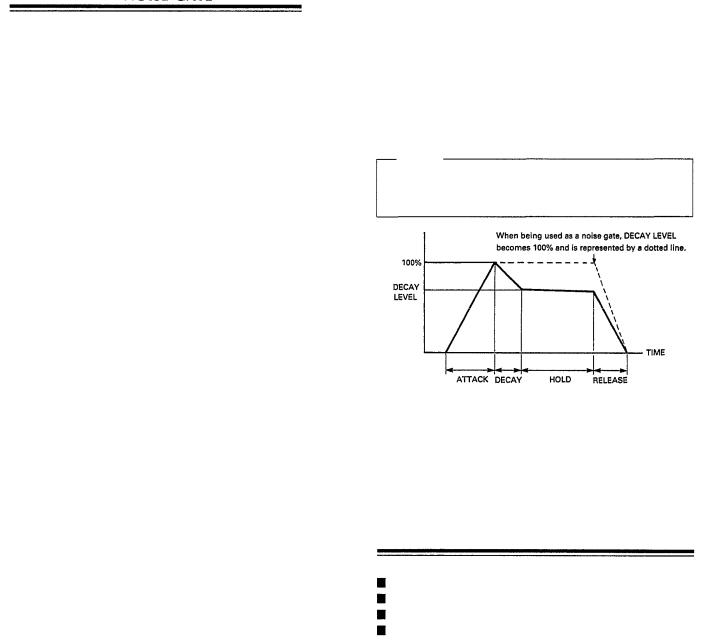
PARAMETERS ACCESSED BY THE INT PARAM KEY
High-pass Filter Frequency (HPF FRQ): THRU, 32 Hz
– 1.0 kHz
Permits rolling off the low-frequency content of the reverb signal above the set frequency. The HPF is OFF when set to THRU.
Low-pass Filter Frequency (LPF FRQ): 1 – 16 kHz, THRU
Permits rolling off the high-frequency content of the reverb signal above the set frequency. The LPF is OFF when set to THRU.
NOISE GATE
19. ADR-NOISE GATE
This program uses a “gate” to pass or shut off the input signal in a number of ways. It can be used to pass just a short segment of a longer input signal, or it can be set up to pass only signals that exceed a specified level. In the latter case this program functions as a “noise gate.” It is also possible to create reverse gate type effects in which the gain increases gradually after the effect is triggered.
PARAMETERS ACCESSED BY THE PARAM KEY
Trigger Level (TRG. LEVEL): 0 – 100%
Determines the level of the input signal required to trigger “opening” of the gate. At 100% only very high-level input signals will trigger the gate, while at 0% even the tiniest input signal will trigger the gate.
Trigger Delay (TRG. DLY): -100 – +100 milliseconds
Produces a delay between the time at which the gate is triggered and that at which it actually opens. If a minus value is programmed, the input signal is delayed so that, effectively, the gate opens before the signal appears.
Trigger Mask (TRG. MSK): 3 – 24000 milliseconds
This parameter makes it impossible to re-trigger the gate function until the programmed time has elapsed.
Attack Time (ATTACK): 3 – 24000 milliseconds
Determines how long it takes for the gate to open fully from the time it begins to open.
Decay Time (DECAY): 3 – 24000 milliseconds
Determines the length of time it takes for the gate envelope to fall to DECAY LEVEL after it is fully open.
Decay Level (DECAY LVL): 0 – 100%
Determines the level at which the gate remains open for the HOLD TIME. The lower the value, the lower the HOLD gate level.
Hold Time (HOLD): 1 – 24000 milliseconds
Determines how long the gate stays open, allowing the signal to pass at the DECAY LEVEL, after the first decay and prior to beginning of the RELEASE TIME.
Release Time (RELEASE): 3 – 24000 milliseconds
Determines how long it takes for the gate to close fully after the HOLD TIME has ended.
Analog Trigger Level (A. TRG LVL): 0 – 100%
When an analog signal applied to the rear-panel TRIGGER 2 ANALOG jack is used to trigger the gate, this parameter determines the level of the input signal required to trigger “opening” of the gate. At 100% only very high-level input signals will trigger the gate, while at 1% even the tiniest input signal will trigger the gate. When this function is used the TRG. LEVEL parameter should be set to the highest value (100%) so that only signals applied to the TRIGGER 2 ANALOG jack will activate the gate.
MIDI Trigger (MIDI TRG.): OFF, ON
When this parameter is turned ON, a KEY ON EVENT message from an external MIDI keyboard can be used to trigger the gate. A KEY ON EVENT message is transmitted whenever a note on a MIDI keyboard is played.
NOTE:
This effect can also be triggered by the front-panel TRIGGER key or a footswitch plugged into the rear-panel TRIGGER 1 SW jack.
PARAMETERS ACCESSED BY THE INT PARAM KEY
High-Pass Filter Frequency (HPF FRQ): THRU, 32 Hz
– 1.0 kHz
Low-Pass Filter Frequency (LPF FRQ): 1 – 16 kHz, THRU
PITCH CHANGE TYPE PROGRAMS
20. PITCH CHANGE 1
2 1 . PITCH CHANGE 2
22. PITCH CHANGE 3
39. STEREO PITCH
19
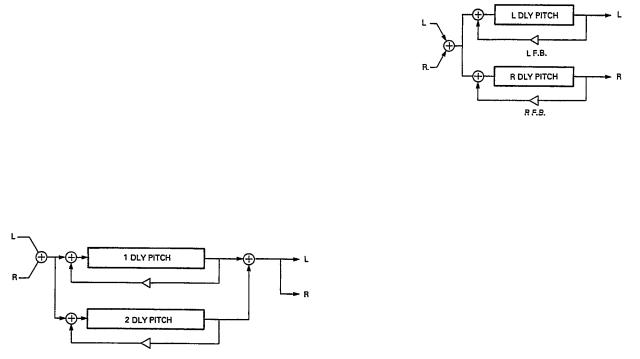
PARAMETERS ACCESSED BY THE PARAM KEY
 20. PITCH CHANGE 1
20. PITCH CHANGE 1
PITCH CHANGE 1 makes it possible to produce two independently pitch-shifted output notes in addition to the direct signal, so you can create three-part harmonies with a single input note. Both pitch-shifted notes appear at the center of the stereo sound field.
1st Pitch Shift (1 PITCH): -24 – +24 2nd Pitch Shift (2 PITCH): -24 – +24
Set the pitch of the first or second pitch-shifted note between two octaves below (-24) and two octaves above (+24) the input note.
1st Fine Tuning (1 FINE): -100 – +100 2nd Fine Tuning (2 FINE): -100 – +100
Permit fine tuning of the first or second pitch-shifted note in l-cent steps.
1st Delay Time (1 DLY): 0.1 – 2300 milliseconds 2nd Delay Time (2 DLY): 0.1 – 2300 milliseconds
Determines the time delay between input of the original note and output of the first or second pitch-shifted note.
1st Feedback Gain (1 F.B.): -99 – +99 2nd Feedback Gain (2 F.B.): -99 – +99
When this parameter is set to 0, only a single pitch-shifted sound is produced after the DELAY time has elapsed. As the value of this parameter is increased, however, more and more delayed repeats are produced, each pitch-shifted up or down from the previous repeat according to the setting of the PITCH parameter.
1st Level (1 LEVEL): 0 – 100% 2nd Level (2 LEVEL): 0 – 100%
These parameters determine the levels of the first and second pitch-shifted notes.
 21. PITCH CHANGE 2
21. PITCH CHANGE 2
Like the PITCH CHANGE 1 program, PITCH CHANGE 2 produces 2 pitch-shifted notes in addition to the original input note. In this program, however, the two pitch-shifted notes are independently fed to the left and right channel outputs (the direct sound is positioned at the center of the stereo sound field) for a true stereo harmony effect.
Left Pitch Shift (L PITCH): -24 – +24 Right Pitch Shift (R PITCH): -24 – +24
Set the pitch of the left or right channel pitch-shifted note between two octaves below (-24) and two octaves above (+24) the input note.
Left Fine Tuning (L FINE): -100 – +100 Right Fine Tuning (R FINE): -100 – +100
Permit fine tuning of the left or right channel pitch-shifted note in l-cent steps.
Left Delay Time (L DLY): 0.1 – 2300 milliseconds Right Delay Time (R DLY): 0.1 – 2300 milliseconds
Determine the time delay between input of the original note and output of the left or right channel pitch-shifted note.
Left Feedback Gain (L.F.B.): -99 – +99 Right Feedback Gain (R.F.B.): -99 – +99
When this parameter is set to 0, only a single pitch-shifted sound is produced after the DELAY time has elapsed. As the value of this parameter is increased, however, more and more delayed repeats are produced, each pitch-shifted up or down from the previous repeat according to the setting of the PITCH parameter.
 22. PITCH CHANGE 3
22. PITCH CHANGE 3
PITCH CHANGE 3 offers the “thickest” and most complex sound by allowing the creation of three pitch-shifted notes in addition to the direct sound.
1st Pitch Shift (1 PITCH): -24 – +24 2nd Pitch Shift (2 PITCH): -24 – +24 3rd Pitch Shift (3 PITCH): -24 – +24
Set the pitch of the first, second or third pitch-shifted note between two octaves below (-24) and two octaves above (+24) the input note.
1st Fine Tuning (1 FINE): -100 – +100 2nd Fine Tuning (2 FINE): -100 – +100 3rd Fine Tuning (3 FINE): -100 – +100
Permit fine tuning of the first, second or third pitch-shifted note in l-cent steps.
1st Delay Time (1 DLY): 0.1 – 4600 milliseconds 2nd Delay Time (2 DLY): 0.1 – 4600 milliseconds 3rd Delay Time (3 DLY): 0.1 – 4600 milliseconds
20
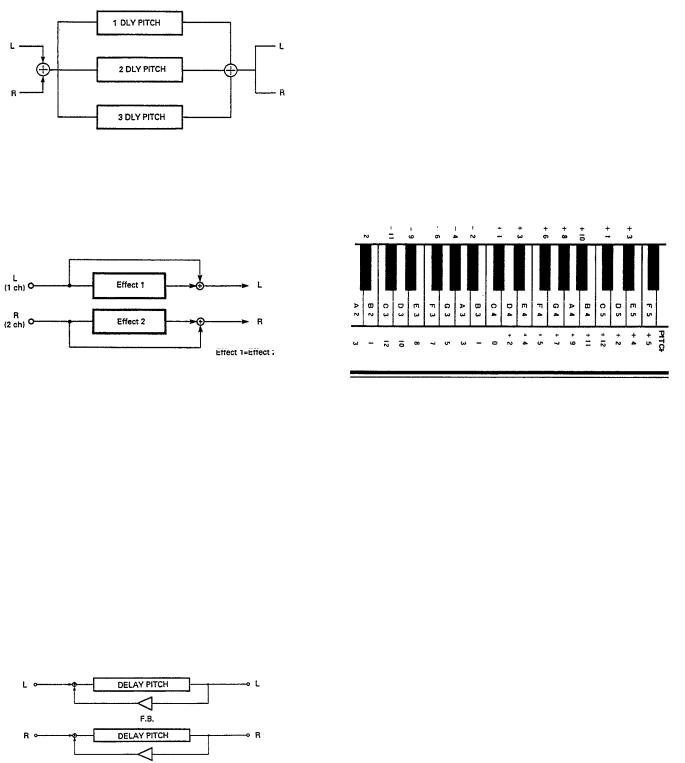
Determines the time delay between input of the original note and output of the first, second or third pitch-shifted note.
1st Level (I LEVEL): 0 – 100% 2nd Level (2 LEVEL): 0 – 100% 3rd Level (3 LEVEL): 0 – 100%
These parameters determine the levels of the first, second and third pitch-shifted notes.
 39. STEREO PITCH
39. STEREO PITCH
The STEREO PITCH program produces a smooth pitch shift effect rather than an abrupt shift from note to note. The parameters affect both the left and right channels simultaneously.
Pitch Shift (PITCH): -24 – +24
Set the pitch of the pitch-shifted note between two octaves below (-24) and two octaves above (+24) the input note.
Fine Tuning (PITCH FINE): -100 – +100
Permit fine tuning of the pitch-shifted note in l-cent steps.
Delay Time (DELAY): 0.1 – 2300 milliseconds
Determine the time delay between input of the original note and output of the pitch-shifted note.
Feedback Gain (FB GAIN): -99 – +99
When this parameter is set to 0, only a single pitch-shifted sound is produced after the DELAY time has elapsed. As the value of this parameter is increased, however, more and more delayed repeats are produced, each pitch-shifted up or down from the previous repeat according to the setting of the PITCH parameter.
PARAMETERS ACCESSED BY THE INT PARAM KEY
Base Key (BASE KEY): OFF, C1 – C6
This parameter sets the “BASE KEY” for an external MIDI synthesizer used to control the PITCH parameter (the MIDI OUT terminal of the synthesizer must be connected to the SPX1000 MIDI IN terminal, and the SPX1000 must be set to receive on the MIDI channel on which the synthesizer is transmitting). If, for example, the BASE KEY parameter is set to C4, pressing the C3 key on the synthesizer (C3 is one octave lower than C4) will set the pitch change value to -12. Pressing D4 on the keyboard would produce a pitch increase of one whole-tone (+2). When two keys are pressed, the highest note determines the pitch of the 1 PITCH or L PITCH sound, and the lower note determines the pitch of the 2 PITCH or R PITCH sound. With the STEREO PITCH program the last note pressed takes priority. If a key more than two octaves higher or lower than the BASE KEY is pressed, the resultant pitch change setting will still be within the -24 to +24 range, as shown in the illustration below. If the BASE KEY parameter is set OFF, pitch cannot be controlled via the MIDI IN terminal.
FREEZE PROGRAMS
23.FREEZE 1
24.FREEZE 2
40. STEREO FREEZE
The FREEZE programs allow sampling (digital recording) and playback of sounds received at the SPX1000’s inputs. The FREEZE 1 and FREEZE 2 programs permit sampling for a maximum of 5.8 seconds, while the STEREO FREEZE program allows sampling for a maximum of 2.9 seconds. The FREEZE 1 and FREEZE 2 programs differ only in the playback functions provided.
PARAMETERS ACCESSED BY THE PARAM KEY
 23. FREEZE 1
23. FREEZE 1
The FREEZE 1 program allows single playback of the sampled sound, with adjustable start and end points.
Record Mode (REC. MODE): MANUAL, AUTO
Determines how sampling is to be triggered. If MANUAL is selected, sampling is initiated either by pressing the parameter
 key, the TRIGGER key, or a footswitch connected to the rear-panel TRIGGER 1 SW jack. If AUTO is selected, sampling is automatically triggered by any input signal of sufficient level.
key, the TRIGGER key, or a footswitch connected to the rear-panel TRIGGER 1 SW jack. If AUTO is selected, sampling is automatically triggered by any input signal of sufficient level.
21
